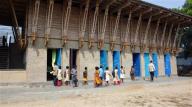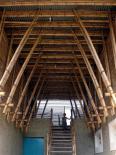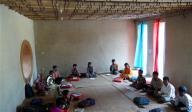KUALA LUMPUR (Reuters Life!) -
Tue Sep 4, 2007 8:33AM EDT
Mud-and-bamboo school shares in architecture prize

A Bangladeshi school, designed by architects Anna Heringer of Austria and Eike Roswag of Germany, is seen in the northwestern village of Rudrapur in this April 2007 handout released by Aga Khan Award. The school, built from clay-mud and bamboo by its own pupils and teachers, shared in the world's richest architecture prize on Tuesday. Credit:REUTERS/Aga Khan Award/Handout

A Bangladeshi school, designed by architects Anna Heringer of Austria and Eike Roswag of Germany, is seen in the northwestern village of Rudrapur in this April 2007 handout released by Aga Khan Award. The school, built from clay-mud and bamboo by its own pupils and teachers, shared in the world's richest architecture prize on Tuesday.
REUTERS/Aga Khan Award/Handout.

Students sit inside a Bangladeshi school, designed by architects Anna Heringer of Austria and Eike Roswag of Germany, in the northwestern village of Rudrapur in this April 2007 handout released by Aga Khan Award. The school, built from clay-mud and bamboo by its own students and teachers, shared in the world's richest architecture prize on Tuesday.
REUTERS/Aga Khan Award/Handout
A Bangladeshi school built from clay-mud and bamboo by its pupils and teachers shared in the world's richest architecture prize on Tuesday.
It was among nine projects that split the $500,000 Aga Khan award, awarded every three years and founded by philanthropist Prince Karim Aga Khan in 1977 to recognize and encourage designs that met "the needs and aspirations of Muslim societies".
The school, in the village of Rudrapur in northwest Bangladesh, was built by hand in four months by local craftsmen, pupils, parents and teachers under the direction of architects Anna Heringer from Austria and Eike Roswag from Germany.
"This joyous and elegant two-storey primary school in rural Bangladesh has emerged from a deep understanding of local materials and a heart-felt connection to the local community," the awards jury said in its citation.
Other winners included a Malaysian university campus designed by Norman Foster's Foster + Partners, the firm behind London's iconic "gherkin" office tower.
Three projects to restore historic quarters in Yemen and Cyprus -- the mud-brick high-rise buildings of Shibam, the 16th-century Amiriya Complex and the old walled city of Nicosia -- were also awarded.
Other winners were the Central Market complex in Koudougou, Burkina Faso, the Dutch embassy in Addis Ababa, Singapore's 28-storey Moulmein apartment tower and Beirut's Samir Kassir Square which features a reflecting pool.
The team behind each project receives an equal share of the overall prize, amounting to about $55,500 each, a spokesman for the Aga Khan Development Network said.
The awards were handed out Malaysian Prime Minister Abdullah Ahmad Badawi at Kuala Lumpur's twin towers.


